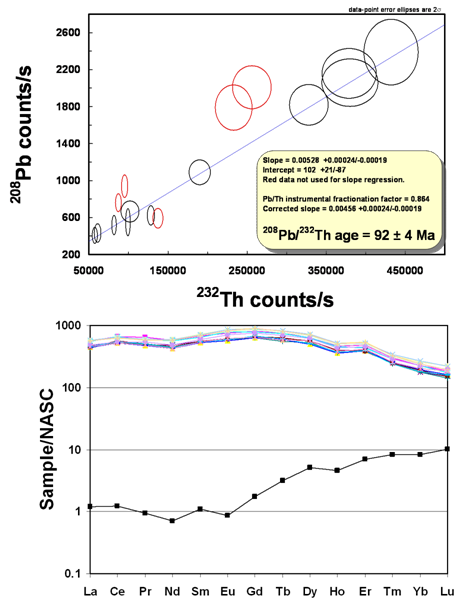Reports: ND255770-ND2: Uranium-Thorium-Lead Chronology of Source Rock Deposition and Diagenesis, an in Situ and Whole Rock Study TOC-Rich Shales
Thomas J. Lapen, University of Houston
Two Projects are reported: 1) New developments in data acquisition and reduction, and 2) Th-Pb isotope systematics and chronology of fish bone
Two Projects are reported: 1) New developments in data acquisition and reduction, and 2) Th-Pb isotope systematics and chronology of fish bone.
1) Data Reduction Software Development for U-Pb Geochronology at the University of Houston
The U-Pb geochronology laboratory overseen by the PI at the University of Houston uses a Photon Machines Analyte 193 ArF excimer laser attached to a pulse counting detector fitted to a Varian 810 quadrupole mass spectrometer and machine parameters typically follow those outlined in Shaulis et al. (2010). ICP-MS data is recorded and exported using the instrument Quantum software, which does not have the any post data reduction data visualization capabilities, only raw data acquisition. A new MATLAB-based graphical user interface (GUI) U-Pb data reduction software was developed to allow the lab user to see a reduced version of their data during each run during acquisition to avoid unnecessarily long runs and unnecessarily large data sets for relatively easily characterized samples, and to quality check standard analyses “on the fly” during data acquisition. This program imports integrated isotopic ratios from Quantum software exported files, parses that data file, reduces it and filters the data based on user-defined parameters, and automatically plots fractionation corrections for user-defined standard isotopic ratios, as well as concordia and distribution diagrams in an interactive environment for ease of reducing and quality checking data (Figure. 1). This new data reduction software allows the user to see their data as they acquire it, incorporates a variety of data filters for flexibility in data reduction and interpretation, provides options for exporting fully vectored figures, and reduced data export to spreadsheets.
 Figure. 1. MATLAB-based graphical user interface (GUI) designed for reducing integrated U-Pb data.
Figure. 1. MATLAB-based graphical user interface (GUI) designed for reducing integrated U-Pb data.
2) Uranium, Thorium, and Lead isotope geochemistry of petroleum source rocks:
An example from the Eagle Ford Group, Texas
The U-Th-Pb isotope systematics of TOC (total organic carbon)-rich sedimentary rocks are investigated to test the potential for these isotope systems to record the timing of deposition and periods of diagenesis. The samples investigated for this project were derived from the well-dated Upper Eagle Ford Formation (UEFF), within the Eagle Ford Group (EFG), located in south-central Texas. The sample is dated at 90.6 Ma based on the age model of Eldrett et al. (2015).
In situ analyses of U, Th, and Pb isotope ratios and rare earth element (REE) abundances of fish bone phosphate and carbonate calcispheres were conducted by laser ablation inductively-coupled plasma mass spectrometry (LA-ICPMS). Qualitative element abundances and sample maps were conducted by scanning electron microscopy (SEM) and EDS. Thorium-lead isotope data yield an age of 92±4 Ma indicate that the fish bones have retained their original, or very early, diagenetic Th-Pb isotope systematics, making them promising candidates for dating shale deposition. The U-Pb isotope systematics indicate that U was mobilized and greatly enriched in fish bone very late, perhaps only several million years ago. This late U mobility may complicate interpretations of U isotope compositions as an indicator of redox conditions.
Preliminary research highlights:
- Thorium was not significantly redistributed long after deposition, whereas U was.
- The Th retained in the phosphate grains provide a possible new method for constraining depositional ages in fish bone-bearing sedimentary rocks.
- Late stage U mobilization may affect paleoredox interpretations of ocean water chemistry.
- The timing of REE incorporation is unclear from these data.
- Further in situ analysis of fish bone samples is needed in order to better constrain the U-Th-Pb isotope systematics. Thick sections, with larger fish bones, have been targeted and analyzed to produce larger, more precise signals; these data are being processed.
Figure 2(TOP): Plot of 208Pb counts/s (CPS) versus 232Th CPS as measured for the two representative fish bones. Black data are used in the slope and intercept regression; red data are excluded from the regression due to the presence of cracks and altered material. The age is determined from the slope of the data following the simple radioisotope decay equation: (D*/N) = (eλt-1) where D* = atoms of radiogenic daughter (208Pb); N = atoms of the parent nuclide (232Th); λ = decay constant for 232Th; t = time. The slope of the data array is proportional to age. The instrumental fractionation-corrected age is 92±4 Ma (2σ). Figure 2(BOTTOM): Plot of the North American shale composite (NASC)-normalized REE abundances (e.g. Gromett et al., 1984) of the fishbone phosphates (colored lines) and matrix calcispheres (average of 3 analyses; black).
References
Eldrett, J.S., Ma, C., Bergman, S.C., Lutz, B., Gregory, F.J., Dodsworth, P., Phipps, M., Hardas, P., Minisini, D., Ozkan, A. and Ramezani, J., 2015. An astronomically calibrated stratigraphy of the Cenomanian, Turonian and earliest Coniacian from the Cretaceous Western Interior Seaway, USA: Implications for global chronostratigraphy. Cretaceous Research, 56, pp.316-344.
Gromet, L.P., Haskin, L.A., Korotev, R.L. and Dymek, R.F., 1984. The “North American shale composite”: its compilation, major and trace element characteristics. Geochimica et Cosmochimica Acta, 48(12), pp.2469-2482.
Shaulis, B., Lapen, T. J., and Toms, A., 2010. Signal linearity of an extended range pulse counting detector: Applications to accurate and precise U‐Pb dating of zircon by laser ablation quadrupole ICP‐MS: Geochemistry, Geophysics, Geosystems, v. 11, no. 11.












